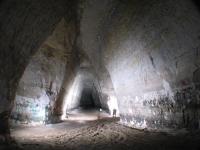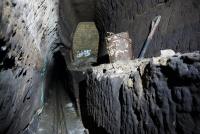(Jeu. 22 Oct. 2020, 13:06)KarlHungus a écrit : Never had any collapsing? what's the terrain like above? like, how much sandstone is there before you'd meet the soil if you'd be digging up?
The sandstone is largely self-supporting with even a small curve at the top. We did put a false ceiling in one room (the circular donut room) because of some minor cracks, but that was mostly for visible uniformity. The owner (Slim Jim) wants to have several confusing parts that look identical and require people to explore rather than navigate by landmarks. We've come across a few natural crevices in the sandstone, but they haven't impacted stability. As to depth, most of the tunnels are 50-100ft underground vertically. The network is built into the side of a steep hill. If you dug straight up from the deepest part, you would hit a limestone ledge on top of the sandstone.
Our local area has a history of sandstone tunnels and underground sand quarries (usually they're called caves for some reason). They aren't as old as tunnels in Europe, but we have some that remained stable for ~ 150 years, so we're pretty confident that our tunnels will last! There are also a few natural caves in the sandstone that are probably thousands of years old, including some with really massive chambers and passages.

The one thing that would quickly destroy a sandstone tunnel is moving water. We almost lost a major waterfall in the 1860s due to a tunnel collapse.
https://www.mnopedia.org/event/st-anthon...ber-5-1869 Our deep drains and sewers are all dug in sandstone. The sanitary sewers generally are only lined at the bottom or trough because the flow doesn't go higher.

The big storm drains have to be fully lined, and if the cement cracks, the water can quickly erode a cave outside the lining.




![[Image: tenor.gif?itemid=12431147]](https://media1.tenor.com/images/f4eba342764ebdfe5d95f13928098741/tenor.gif?itemid=12431147)